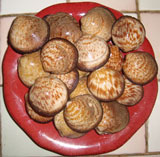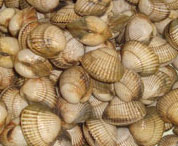Clams Ahoy!
Everything you always wanted to know about Clams but were afraid to ask!!
Types of Clams
All clams are divided into two parts: freshwater and saltwater. Let’s start with saltwater. Let’s start with saltwater clams native to the US Gulf and Atlantic Coasts, concentrating on food clams first.
Steamers
Perhaps the most famous clam, steamer clams, Mya arenaria, are popular in the summer along the Atlantic seaboard. A steamer clam is about 2-4” long and harvested from mud flats where they live. It is a soft-shelled clam, meaning it is all too easy to break the shell with one’s fingers. (Any fresh clam with a broken shell should not be eaten.) Steamers are best harvested by digging without using machinery. Steamers can be located by the small holes in the sand through which they eject water at low tide. You dig by hand and find them generally twelve to eighteen inches under the sand. You don’t know summer, unless you have enjoyed steamers. Digging a mess of perhaps 50 legal steamers requires two to three kids under twelve, low tide, a clam bucket and a can of beer for Dad. Or, two kids and Dad yelling a lot. A surprise you will find when digging steamers, is the clams are able to sense you trying to grab them, and can dig away from you surprisingly fast trying to escape.
Quahogs
The largest of the hard-shelled clams, quahog, sometimes spelled quahaug (a Narragansett word pronounced CO-hog) shells can constitute ashtrays and frighten newcomers. Do not fear. Your first encounter with a quahog is likely to be feeling one with your feet while swimming.
Technically called the ocean quahog, or Arctica islandica, it is sometimes confused with the Mercenaria mercenaria, also called a quahog. The Mercenaria mercenaria quahog is smaller and often called a Littleneck or Cherrystone depending on size.
Quahog chowder is popular, but unlike chowder made from steamed clams, quahog meats must be tenderized first, generally by pounding with a heavy object. Put another way, quahog chowder is popular because eating steamed quahogs is not all that enjoyable, they are too chewy. If you’re lucky, you can dig up that first quahog you felt with your feet swimming, then swim back down to the bottom to pull up a lot more like it. Otherwise, quahogs are hand-raked up from the sand while wading up to about waist-level. Commercially, quahogs are harvested by trawlers that drag giant rakes behind them.
Cherrystones
Should you find yourself someplace interesting in summer in North America, where you can swim in the ocean without all your friends screaming they are freezing to death, the bar where you are ordering a beer should have “clams on the half shell” or cherrystones. They are served with lemon wedges and cocktail sauce. They are delicious! Shucked, which means, “opened,” a cherrystone is about the same width as a golf ball. Normally, eating raw clams does not cause any stomach problems. The warnings you now see are legally mandated, or used to try and protect the restaurant from legal liability should you get sick. Nevertheless, millions of people eat raw clams every year and very few of them become ill.
If you’re worried about this, be sure to put some cocktail sauce on each clam you eat. Research has shown that the capsaicin from the chilies in cocktail sauce, which is what gives them their “heat,” is very effective in killing off any problematic bacteria.
Technically, cherrystones are medium sized Mercenaria mercenaria and also called quahogs.
Littlenecks
The finest of clams, littlenecks are cherrystones except smaller. In fact they are Mercenaria mercenaria - the same species. They are also normally eaten raw on the half-shell, with lemon wedges and cocktail sauce. When digging clams, be careful. Littlenecks are very often too small to be of legal taking size.
Surf Clams
Surf clams, Spisula solidissima, sometimes called sea clams Atlantic surf clams, bar clams, and hen clams are hard shelled clams found in the surf and beyond zone in the sand . They are always underwater even at low tide. They grow up to about 8" long (20 cm) and are found in Maine to Delaware. Sometimes when the surf is enormous, such as during and immediately after a hurricane, they will be found live washed up and shore. There is also the similar and closely related European Surf Clam, or Spisula solida.
Amandes de Mer
 Amandes
de Mer, literally "Almonds of The Sea" in French, are also called Dog
Cockles by the British. They are both farmed and a major by catch of the
European Surf Clam, and fairly widely available in much of Europe. They are
inexpensive asthey get tough if overcooked and need tenderization to be
considered edible when canned, but are delightful fresh and have a sweet and
almond like flavor. I love them!
Amandes
de Mer, literally "Almonds of The Sea" in French, are also called Dog
Cockles by the British. They are both farmed and a major by catch of the
European Surf Clam, and fairly widely available in much of Europe. They are
inexpensive asthey get tough if overcooked and need tenderization to be
considered edible when canned, but are delightful fresh and have a sweet and
almond like flavor. I love them!
 The Common Cockle
The Common Cockle
The Common Cockle, Cerastoderma
edule, is a very common clam which lives from north of Norway all
the way south to Senegal. It is a shallow water species, harvested by raking
on tidal flats as well as farmed, and tasty and commonly eaten in Europe. It
is one of the most plentiful bivalves, and an important food source for
fish, crustaceans, and birds. Because they are so common, they are
relatively inexpensive.
 Hi,
we are Ted and John, just two guys who love Clams and other seafood.
Hi,
we are Ted and John, just two guys who love Clams and other seafood.